I had a very interesting question come across my desk from {grow} community member John Bethune:
In the minds of most people, journalism and marketing were once diametrically opposed. Has that changed in the social media era?
A great question! And, in fact, I think the social web has brought these disciplines together in a number of surprising ways.
The ideal of journalism is a quest for truth. Marketing is the quest for a product’s “truth.” By that I mean the best marketers are on a journey to know how their company’s goods and services exist in the hearts and minds of their customers. Then, their job is to express that consumer truth to the best of their ability. So in this way, the disciplines are unexpectedly similar, although the end product is quite different!
But the social web has created an important shift for both disciplines. What does it even mean to be a journalist today? Through blogging and technology like smartphone video cameras, journalism has been democratized. Anybody can report, anybody can publish. Jeff Jarvis of City University of New York recently defined a reporter today as simply somebody who can say, “I was there and you weren’t.”
The democratization of marketing
 To a great extent, marketing has been democratized, too. Remember last year when Gap changed their logo and there was such an outcry? I felt empathy for the company because they are probably good marketers who followed a traditional protocol — work with graphic designers, test it, get feedback, and roll. That system has worked for decades and changing a logo is not an easy or flippant decision for a consumer product company to make. I’m sure they had done their homework … or at least they thought so.
To a great extent, marketing has been democratized, too. Remember last year when Gap changed their logo and there was such an outcry? I felt empathy for the company because they are probably good marketers who followed a traditional protocol — work with graphic designers, test it, get feedback, and roll. That system has worked for decades and changing a logo is not an easy or flippant decision for a consumer product company to make. I’m sure they had done their homework … or at least they thought so.
But a few vocal people thought the new logo was stupid (perhaps people who were not even customers!). Through Twitter and Facebook, they created an anti-logo movement. and suddenly it became an embarrassing meme. I can imagine the Gap marketers waking up to this one morning and thinking “Wait … what?”
So something as important as an adjustment to your brand image may not even be in the hands of marketers any more. The Gap’s marketing strategy had essentially been crowd-sourced! Like journalism it seems, marketing has also been democratized.
Content as power
The production of content has also been an output of the marketing process, usually in the form of advertisements. But now content is at the very centerpiece of many strategies as companies fight to attract attention on the crowded social web. The journalism schools are full of new applicants. Why? Because content is big business now and the new media channels have an insatiable need for it. Companies need story-tellers as much as marketing graduates.
I have recently been working with the president of one of my B2B customers on a blog and a series of how-to videos to demonstrate their new robotic technologies. I’ll bet five years ago he never would have dreamed he would be in the publishing business!
So this idea of content and storytelling is another way that journalism and marketing have been brought together. For both fields, content that moves virally through the social web represents success and power.
Truth as a strategy
I think expectations of “truth” and transparency is another way the social web have brought journalism and marketing together. For a brand to have integrity and to be successful, it can’t be spinning the truth around any more. There are a million watch dogs out there now and any one of them can sniff out a fake.
A few weeks ago, I was working with some marketers for a hotel chain and we were discussing negative hotel reviews. “We don’t mind them,” they told me. “It makes us more real.”
Interesting. Truth as a marketing strategy.
My hunch is that a few years ago, that is not necessarily what their reaction would have been. In marketing, truth is the new black.
Maybe journalism and marketing are getting closer than we thought? What do you think?
Note: John Bethune’s full interview with me can be found here: “Content is Power: A Q&A with Mark W. Schaefer.”



